- The AI tumor ablation surgical robot from Baird Medical has won honors at the Medical Industry Innovation Competition in China, marking a significant leap forward in medical technological innovation.
- The robot utilizes microwave ablation (MWA) for precise and minimally invasive procedures in interventional oncology.
- President Haimei Wu leads the company with a focus on AI, collaborating with open-source communities and partnerships with academic institutions.
- Baird Medical holds FDA 510(k) certification and collaborates with major healthcare providers in the United States, including Johns Hopkins Hospital.
- The company’s influence extends to over 30 American hospitals and 20 countries, highlighting its leadership in thyroid microwave ablation devices.
- AI and digital innovation are crucial tools for modern healthcare, with Baird Medical at the forefront of this transformative change.
Few neologisms resonate as powerfully as “catalyst for change,” yet, when it comes to the rapidly expanding field of medical technology, this phrase barely scratches the surface. At the heart of this seismic shift lies the recently celebrated AI tumor ablation surgical robot from Baird Medical, which has just won honors at the Medical Industry Innovation Competition in China. This annual showcase is not merely a display of technological gadgets but a prism through which the future of healthcare can be seen, refracted into clearer diagnostics, faster interventions, and improved patient outcomes.
Baird Medical is not just dipping its toes into innovation; it is diving headfirst into the maelstrom of AI-driven healthcare, presenting a surgical assistant aimed at transforming the landscape of interventional oncology. Their robot employs microwave ablation (MWA), a minimally invasive technique executed with razor-sharp precision and real-time decision-making. The image of lab-coated robots skillfully maneuvering may have once seemed the realm of science fiction, but Baird Medical is rapidly pulling that vision into the realm of reality.
At the helm of this scientific odyssey is President Haimei Wu, whose conviction in the power of AI is palpable—a beacon guiding Baird Medical’s mission to elevate healthcare standards globally. The company thrives on a philosophy of collaboration and innovation, intertwining its scientific research with open-source AI communities and prestigious academic institutions. This synergistic approach fosters the development of intelligent systems that could soon guide diagnostic decisions or even predict health crises before they occur.
As an FDA 510(k) certified organization, Baird Medical is not just a voice within the American healthcare landscape; it is a key player, its technologies serving medical giants like Johns Hopkins Hospital and Columbia University Medical Center. Its reach extends to over 30 hospitals across the country and is gradually expanding to more than 20 countries worldwide. On both national and international levels, Baird Medical wears the mantle of market leader in thyroid microwave ablation devices.
In an increasingly uncertain world—economic fluctuations, regulatory changes—Baird Medical stands as a bastion of stability and progress. It offers a glimmer of what the medical community has long sought: a blend of cutting-edge technology with compassionate care. The conclusion here is undeniably clear: AI and digital innovation are not mere supplements but essential tools for the modern physician. As Baird Medical’s influence continues to spread, the prospect of AI-driven surgical solutions becomes not just probable but inevitable.
For those seeking assurance amid the whirlwind of medical advancements, keeping an eye on Baird Medical may well be the necessary compass to navigate the future of healthcare.
AI Surgical Robots: The Future of Oncological Treatment
Revolutionizing Cancer Treatment with AI Tumor Ablation Surgical Robots
The emergence of AI-driven medical technologies marks a transformative era in healthcare, and Baird Medical is leading the charge with its revolutionary AI tumor ablation surgical robot. This advanced technology, recognized at the Medical Industry Innovation Competition in China, illustrates how AI and robotics can enhance diagnostic accuracy, accelerate interventions, and improve patient outcomes, particularly in interventional oncology.
Features and Specifications of Baird Medical’s Surgical Robot
1. Microwave Ablation (MWA): The robot utilizes microwave ablation, a minimally invasive technique that eradicates tumors with precision. This method reduces recovery time and decreases the risk of complications compared to traditional surgery.
2. Real-Time Decision Making: Equipped with AI algorithms, the robot can process data in real time, allowing it to adapt and refine surgical procedures on the fly.
3. Integration with Healthcare Giants: Baird Medical’s technologies are employed by major institutions such as Johns Hopkins Hospital and Columbia University Medical Center, signifying trust and reliability in its innovations.
4. Global Reach: With FDA 510(k) certification, Baird Medical extends its services to over 30 hospitals in the United States and more than 20 countries worldwide, underscoring its global impact.
Industry Trends and Market Forecasts
The market for medical robots is expected to grow exponentially, with a significant focus on AI-driven systems. According to Markets and Markets, the medical robotics market is projected to reach USD 16.7 billion by 2026, fueled by technological advancements and increasing demand for minimally invasive surgeries. Baird Medical is well-positioned to be a key player in this growth, leveraging its expertise in AI to expand its market footprint.
Advantages and Disadvantages of AI in Medical Technology
Advantages:
– Increased Precision: Machines perform tasks with extreme accuracy, minimizing human error.
– Improved Recovery: Minimally invasive techniques promote faster recovery for patients.
– 24/7 Functionality: Robots can work tirelessly without fatigue, providing constant support.
Disadvantages:
– High Initial Costs: Implementing robotic systems requires substantial investment.
– Technical Challenges: Integration with existing medical systems can present hurdles.
– Ethical Considerations: The use of AI in healthcare raises concerns regarding data privacy and accountability for decisions.
Real-World Use Cases
– Oncological Interventions: Robots like those from Baird Medical are used to treat hard-to-reach tumors through conventional surgery, improving survival rates and quality of life for patients.
– Training Tools: AI-powered robots are invaluable for training medical staff, providing simulators that offer real-life scenarios without the associated risks.
Safety and Sustainability
Ensuring the safety of AI systems is crucial. Baird Medical collaborates with cybersecurity experts to protect patient data and maintain system integrity. Additionally, sustainable development practices are integrated into their research and production, aligning with global environmental goals.
Practical Recommendations
– Stay Informed: Healthcare professionals should educate themselves on the capabilities and limitations of AI technologies.
– Consider Integration: Institutions planning to integrate AI surgical systems should assess their specific needs and choose technology that aligns with their goals.
– Emphasize Training: Ongoing training on advanced systems will ensure healthcare providers maximize their potential.
Conclusion
Baird Medical’s AI tumor ablation surgical robot exemplifies a decisive shift in medical technology, promising a future where precision and innovation transform the face of cancer treatment. As AI continues to evolve, it is crucial for healthcare providers to adapt and embrace these technologies to enhance care and patient outcomes. For more information on cutting-edge medical technologies, visit Baird Medical’s website.












